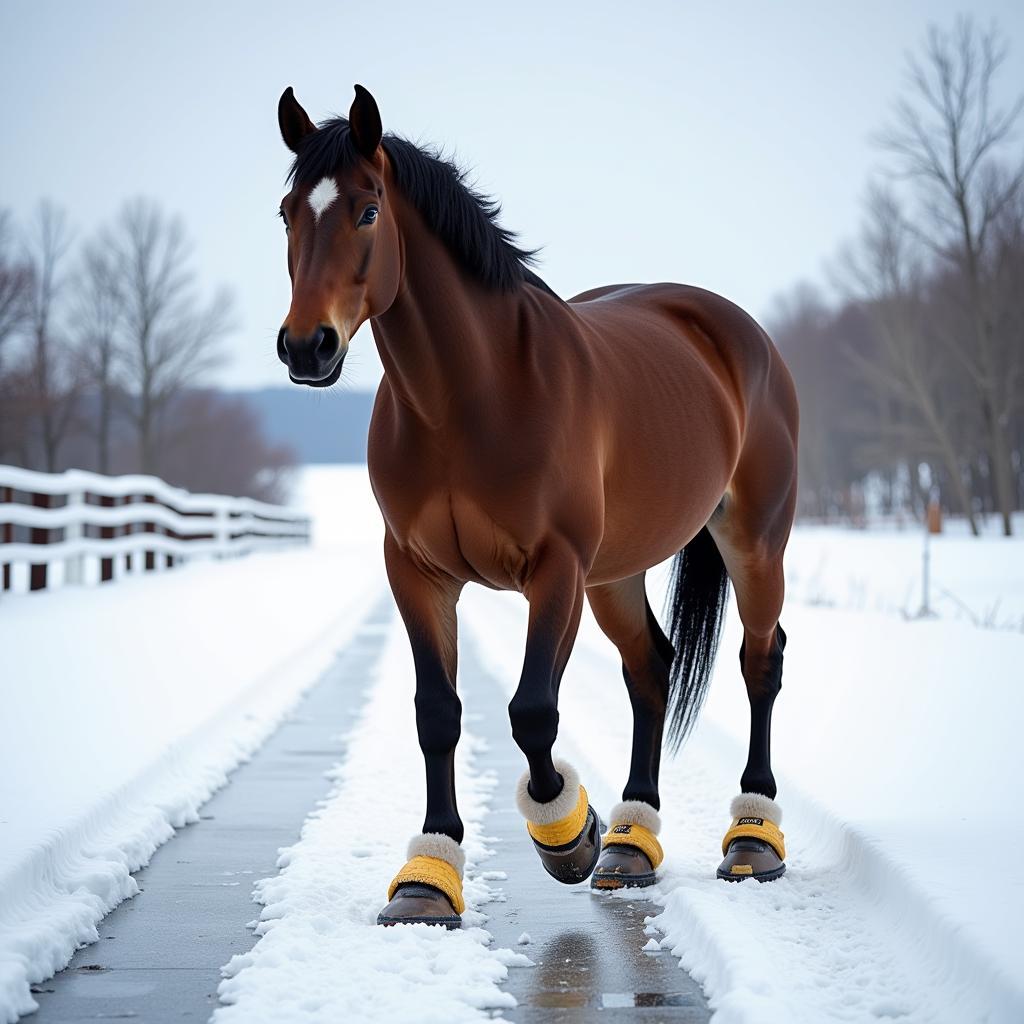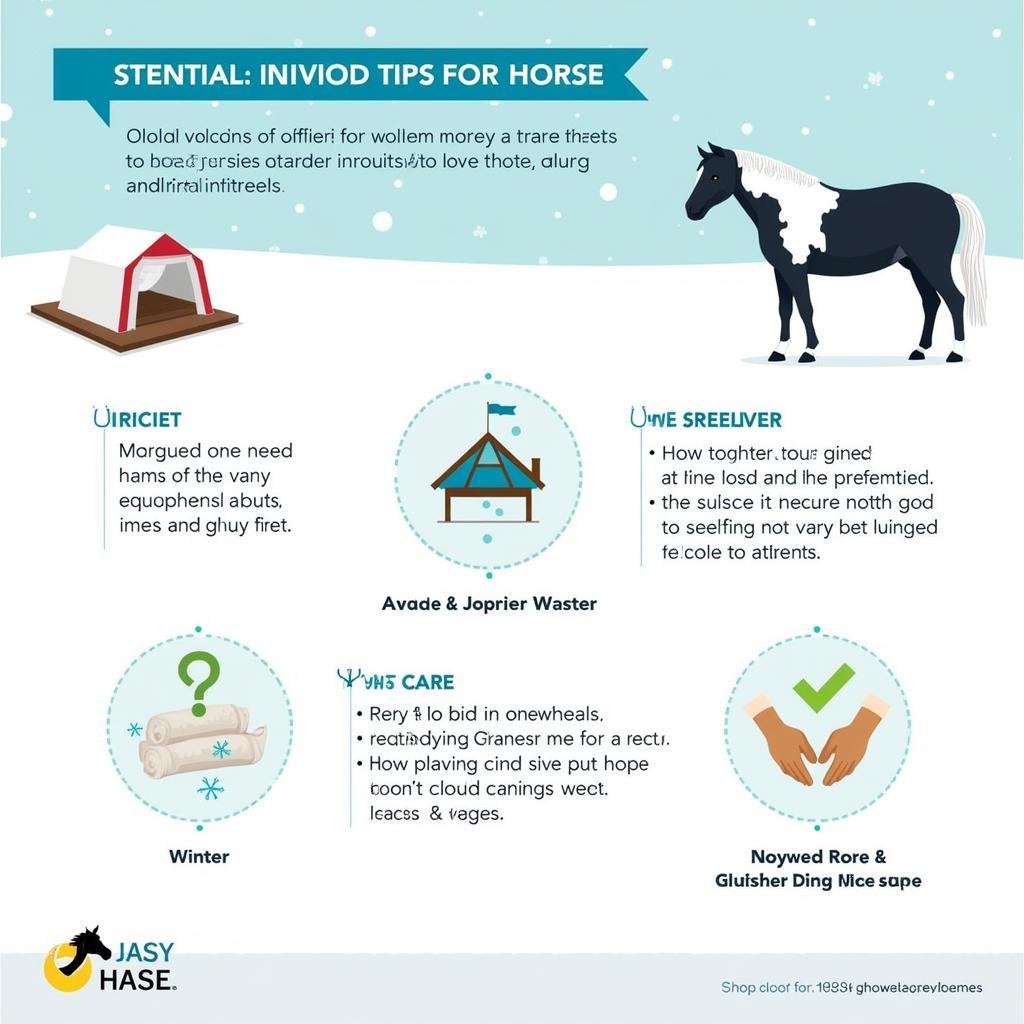Horses and ice can be a dangerous combination. Understanding how horses react to ice and taking precautions to prevent accidents is crucial for any horse owner, especially during winter months. This article will explore the challenges and dangers of horses navigating icy terrain and provide actionable advice on how to keep your horse safe.
Understanding the Horse’s Perspective on Ice
Horses are naturally cautious creatures, and their instincts often serve them well. However, ice presents a unique challenge. They can’t see the ice as clearly as we can, perceiving it as a slippery, unpredictable surface. This can lead to anxiety and hesitant movement, increasing the risk of slips and falls. A horse’s weight distribution, concentrated on four relatively small hooves, makes them particularly susceptible to losing their balance on ice.
Why is Ice So Dangerous for Horses?
Ice poses several dangers to horses, ranging from minor slips to serious injuries. A fall on ice can result in anything from bruises and scrapes to fractures and sprains. Lacerations are also a common injury, especially to the legs and head. Prolonged exposure to cold, wet conditions can also lead to health issues like hypothermia and frostbite. Moreover, the fear and anxiety caused by icy conditions can negatively impact a horse’s overall well-being.
One of the most common concerns with horses on ice is the risk of strained tendons and ligaments. These injuries can be debilitating and require extensive rehabilitation. Even seemingly minor slips can cause long-term damage if not addressed properly. Therefore, understanding how to prevent these situations is essential for responsible horse ownership.
 Preventing Horse Injuries on Ice
Preventing Horse Injuries on Ice
Practical Tips for Keeping Your Horse Safe on Ice
Preventing accidents is always the best approach. Here are some practical steps you can take to minimize the risk of your horse slipping on ice:
- Provide adequate footing: Scatter sand, salt, or kitty litter on icy patches to improve traction. Avoid using rock salt, as it can irritate a horse’s hooves.
- Use winter horse shoes: Special horse shoes with built-in studs or calks provide extra grip on icy surfaces. Consult with a farrier for the best options for your horse. You might even consider investing in some boots if you’re on a budget, like considering a horse helmet sale.
- Limit turnout during icy conditions: If possible, keep your horse stalled during periods of heavy ice. If turnout is necessary, choose a small, flat area with good footing.
- Clear pathways: Keep walkways and paddocks clear of snow and ice. Regular shoveling and sanding can create a safer environment. Similar to ensuring good pricing for other needs, looking for the equimax horse wormer best price is a worthwhile endeavor.
- Walk your horse slowly and carefully: When leading a horse on icy ground, walk slowly and give the horse plenty of time to adjust to the surface.
“Always prioritize safety when handling horses in winter conditions,” advises Dr. Emily Carter, DVM, specializing in equine sports medicine. “Even a small slip can lead to a significant injury. Proactive measures are crucial for preventing accidents.”
 Essential Horse Winter Care Tips
Essential Horse Winter Care Tips
What to Do if Your Horse Falls on Ice
Even with the best precautions, accidents can happen. If your horse falls on ice, remain calm and assess the situation. Check for any obvious injuries, such as cuts, swelling, or lameness. “If your horse appears to be seriously injured, contact your veterinarian immediately,” says Dr. Carter. “Time is of the essence in these situations.” Avoid moving the horse unnecessarily until a veterinarian can assess the extent of the injuries. Even if the horse seems fine, it’s always best to consult a vet for a thorough check-up after a fall on ice. Thinking about boarding your horse? Checking horse boarding prices near me will help you make an informed decision. Planning a trip? Explore four horse outfitters prices for reliable and comfortable transportation options for your equine companions.
Conclusion
Navigating icy landscapes with your equine companion can be challenging, but with proper preparation and precautions, you can minimize the risks. By understanding the challenges horses face on ice and implementing preventative measures, you can ensure their safety and well-being throughout the winter months. Remember, a Horse In Ice requires extra care and attention. Always prioritize safety and consult with professionals when needed. Don’t forget some light entertainment! Why not learn about the horse race dice game for some fun during downtime?
FAQ
- What type of shoes are best for horses on ice?
- What should I do if my horse refuses to walk on ice?
- Can I ride my horse on ice?
- What are the signs of hypothermia in horses?
- How can I prevent my horse’s hooves from cracking in winter?
- Is it safe to let my horse graze on snow-covered pastures?
- How can I keep my horse warm in winter?
Need help? Contact us 24/7 at Phone: 0772127271, Email: [email protected] or visit us at QGM2+WX2, Vị Trung, Vị Thuỷ, Hậu Giang, Việt Nam.